Dell Studio 14z: Thin and Light Done Right
by Jarred Walton on October 20, 2009 3:00 AM EST- Posted in
- Laptops
Dell Studio 14z Gaming and Graphics Performance
One of the biggest drawbacks about entry-level Intel-based notebooks these days is undoubtedly the inferior integrated graphics. Let's be clear: if you don't care about gaming performance, this really isn't a problem; the GMA 4500MHD can handle video decoding and general Windows use without difficulty. Still, Intel IGPs leave a lot to be desired. The solution for now? Why not try and NVIDIA chipset -- like Apple did with the latest MacBook offerings. Of course, this is only a temporary solution, since the latest Core i5/i7 processors will require QPI chipsets, and Intel isn't licensing that technology right now. Hopefully the next-generation Intel IGP will perform better and have the driver support necessary in order to make this a non-issue, but as you can see below the AMD/ATI and NVIDIA IGPs are clearly superior.
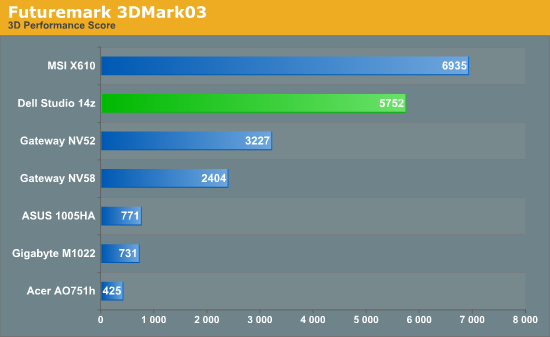
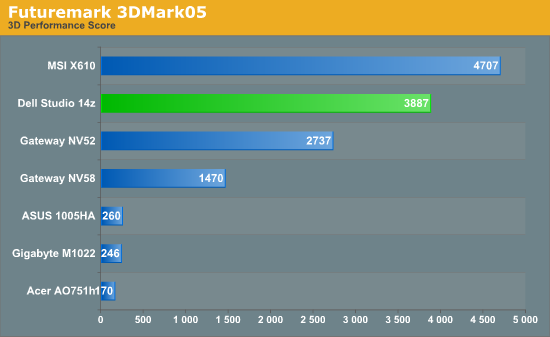
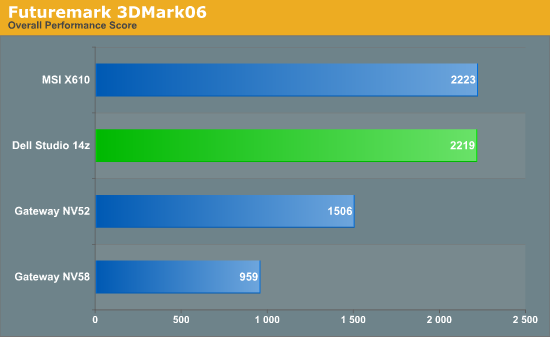
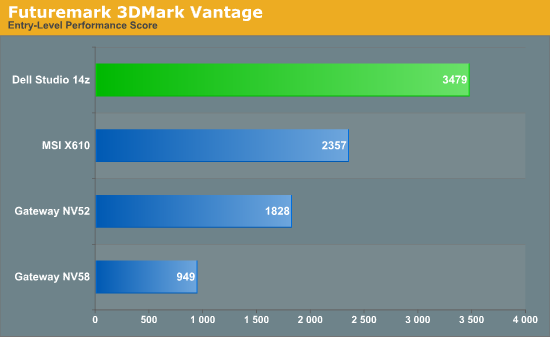
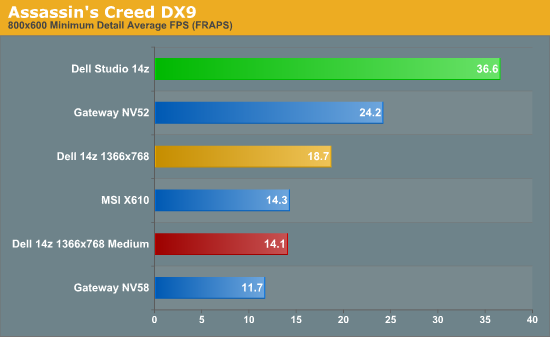
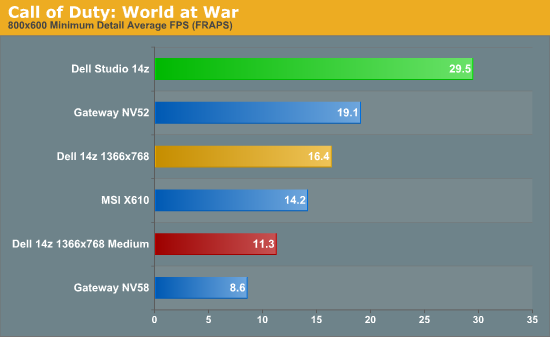
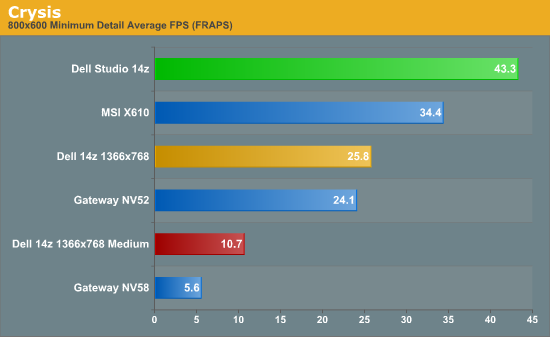

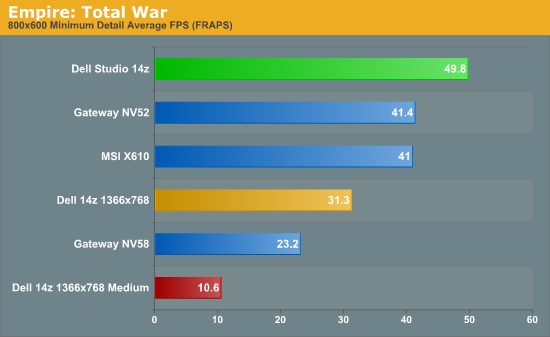
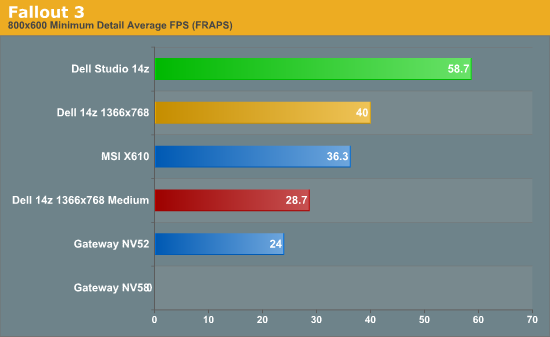
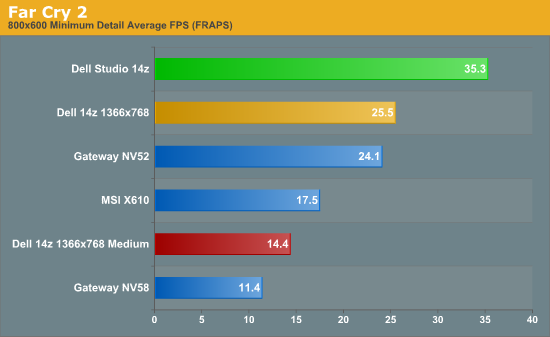
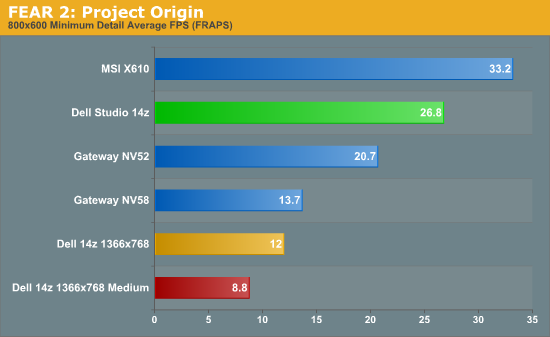

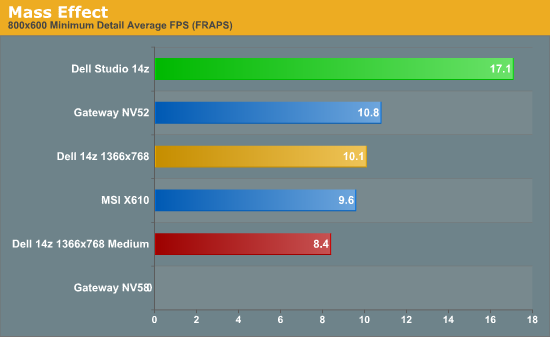


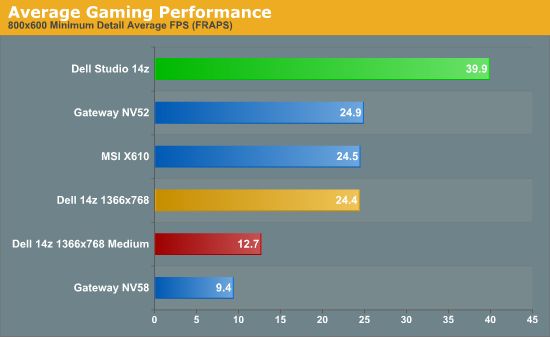
We mentioned in the MSI X610 review that their choice of a discrete GPU with an underpowered single-core CPU ended up resulting in lackluster gaming performance. As 3DMark shows, the HD 4330 certainly has potential, but the MV-40 CPU can't provide enough oomph. The Studio 14z takes a different route: Dell provides a CPU that is plenty fast and pairs it with a reasonably fast IGP. The 9400M combined with an Intel processor puts AMD's mobile platform to shame, delivering on average 60% better frame rates in our tested gaming solutions. Of course, the elephant in the corner is that even the best IGP still struggles to run modern games at minimum detail settings and native LCD resolutions. The 9400M does manage to offer about the same performance at 1366x768 as the HD 3200 at 800x600, with all of the settings at minimum, but you would still need something faster if you wanted to play Mass Effect or Dark Athena.
Focusing on the Studio 14z, when we change to native resolution many games remain playable, but five of the titles deliver frame rates that are not acceptable. Assassin's Creed, Call of Duty: World at War, Dark Athena, FEAR 2: Project Origin, and Race Driver: GRID (along with Mass Effect) need more graphics power, and Crysis and Far Cry 2 are right on the bubble. Take that one step more and set detail settings to medium (instead of minimum) and we find that the 9400M falls flat in every title, with the exception of Fallout 3. Also interesting to note is that the only time where the MSI X610 is faster than the Studio 14z is in FEAR 2, so we would recommend a dual-core 2 GHz processor as the minimum for any "gaming" laptop.
If you're only interested in "casual" games like the Sims or Spore, the 14z won't have any difficulty at all. Even medium detail settings at 1366x768 deliver acceptable performance in such titles.










57 Comments
View All Comments
Shadowmaster625 - Thursday, October 22, 2009 - link
Newegg has a notebook for $399 right now. Please explain how you justify twice the price. A slightly faster processor, slightly more battery life. Big whoop.JarredWalton - Thursday, October 22, 2009 - link
It helps to link to what you're talking about, or at least mention the name. Let's assume you're looking at the http://www.newegg.com/Product/Product.aspx?Item=N8...">Acer Aspire AS5517-5671, which currently sells for $400.1) 15.6" vs. 14.0"
2) 6.0 lbs. vs. 4.6 lbs.
3) AMD Athlon 64 TF-20 (1.6GHz) vs. Core 2 Duo P8600 (2.4GHz)
4) DDR2 vs. DDR3
5) 160GB HDD vs. 320GB HDD
6) "Up to" 2.4 hours vs. 4.5 hours (measured)
When you combine all of those areas, plus chassis design, the Studio 14z is clearly superior to this particular $400 laptop in every way. Does that mean it's worth the extra money? You'll have to decide that. Keep in mind that the Gateway NV52 (benchmarked in this article) is going to be at least 30% faster CPU than the $400 Acer (2.1GHz vs. 1.6GHz), and the 14z with P8600 is almost twice as fast.
If all you need is a basic laptop and you want to save money, sure, go for a cheap $400-$500 laptop. Don't expect top performance or battery life, and you won't be disappointed. Unfortunately, don't expect top quality either (but it's possible you'll still get a notebook that doesn't have any issues).
JimmyJimmington - Friday, October 23, 2009 - link
Also a different GPU, no wireless N, no blue tooth, no esata, no 1600x900 resolution screen.My question would be, if all you care about is saving money, why not go with a $150 netbook refurb? It would certainly be lighter and have more battery life. And if you drop it and it breaks you don't have to feel so bad because you can just go out and buy a new one :D
hybrid2d4x4 - Thursday, October 22, 2009 - link
Thanks for the excellent review, Jarred. I really like how you included the POST times, calling out Dell on glossy finish+screen and LCD quality and also adding FPS bars at the native res. One minor request for future reviews of laptops that are obviously unable to handle top-end games: throw in a Source-based game (or some other older engine) for comparison to show what the cutoff seems to be for what kind of game it actually CAN play well with med/high settings at the native res.On the POST issue, I wonder if there's something about the GF9400 that makes it POST slowly. My Gigabyte 9400-based mobo takes around 10s as well. I know it's not a vendor-specific issue since a Dell Mini 9 I've had my hands on did it in probably under 5s and booted to XP desktop in exactly 25s (8B SSD, uninstalled factory bloatware). I wonder if the Zotac and Asus 9400 boards also POST slowly...
jasperjones - Wednesday, October 21, 2009 - link
very nice review. the comparison you make to the macbook is well-balanced. and i agree that it is a viable--although more expensive--alternative.macs tend to be a good deal shortly after their model refresh (since apple tends to keep prices fixed until the next refresh). my problem with macs is that i don't like os x. basically, i run linux or windows as my main os on a mac. given the hint in a comment that anand might review the new macbook, one thing i'd really like to see on anandtech would be benches and battery performance under operating systems other than os x (yeah, i know linux is gonna suck battery-wise but win 7 might be an interesting option).
Kishkumen - Wednesday, October 21, 2009 - link
If only it didn't have a glossy screen (or rather had a matte option) I'd be the proud owner of one of these otherwise cool, little laptops....Pirks - Tuesday, October 20, 2009 - link
You were putting MacBooks there always, in the relative battery life graphs, but now you don't? Did you get enough hate mail from wintrolls or what? Death threats maybe? ;)Also, do you intend to do a review of the new $999 MacBook they just released? Mighty sweet machine, could you touch it up and pass your thoughts you know? I'd be VERY interested, thanks!
JarredWalton - Tuesday, October 20, 2009 - link
Honestly, I removed the Mac from the graphs more because I know that the testing wasn't entirely Apples to apples. Different browser and web pages mean the Mac may have gotten a boost. Still, when a MacBook can last 3.1 hours with a 45Wh battery on our heaviest load (downloading files, playing a movie, and surfing the web) while a Windows laptop with similar specs can only get 4.5 hours at idle using a 74Wh battery, it's clear that OS X remains better optimized.DominionSeraph - Wednesday, October 21, 2009 - link
I can't wrap my head around the MacBook run times under OS X. I mean, it ain't like there are magically more c and p states available under OS X. And in your OS Mobility roundup you ran Vista in Power Saving mode -- I know that on my desktop that locks my X2 5200+ into its lowest p-state. If that's applicable to the AMD laptops, then the differences can't be explained by Microsoft OS idle processes causing blips to full-throttle.Could you test the MacBook with a MS OS, locked to the lowest SpeedStep setting using RMClock (or the like)? And then try @ max undervolt whilst still locked at idle?
If max undervolt while locked to lowest frequency can't match OS X at stock settings, I think my head will explode.
JarredWalton - Wednesday, October 21, 2009 - link
I can ask Anand to give it a shot... I think he's working on some MacBook articles already so it's definitely something to investigate. But don't discount the possibility that Windows (especially Vista) is preventing the CPU (and peripherals) from entering minimum C-states for long periods of time. Windows seems to constantly "ping" HDDs and other devices to make sure they're still around or something. LOL